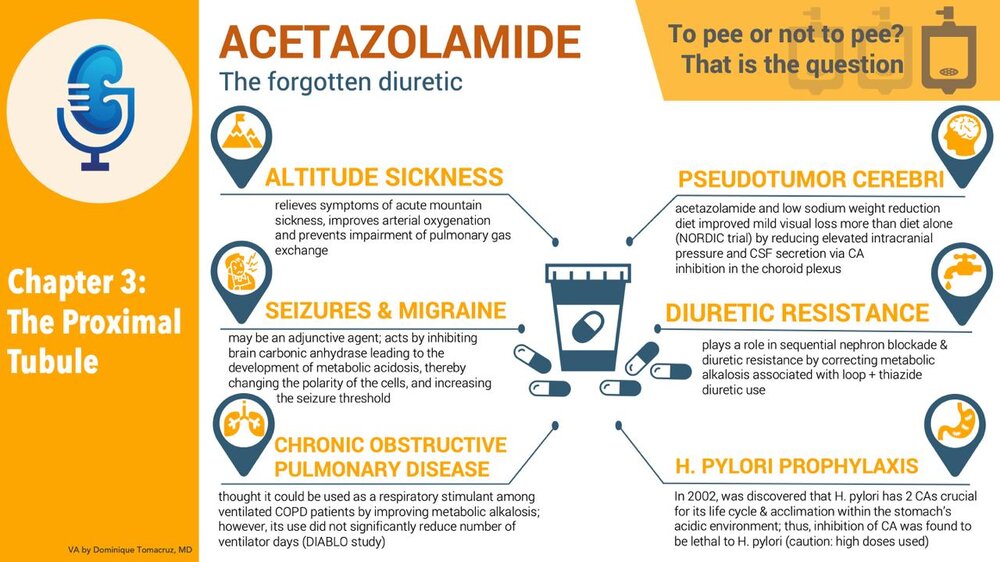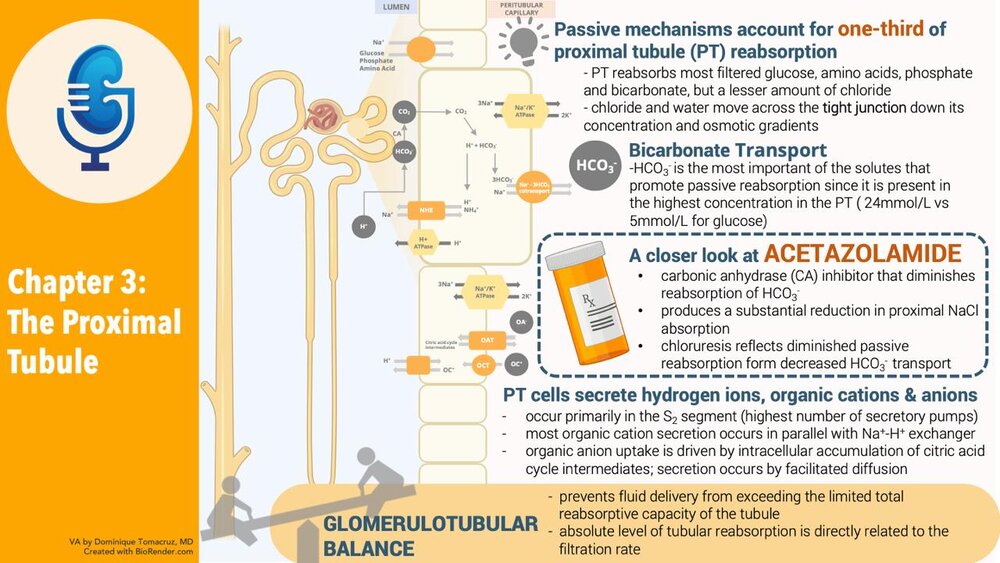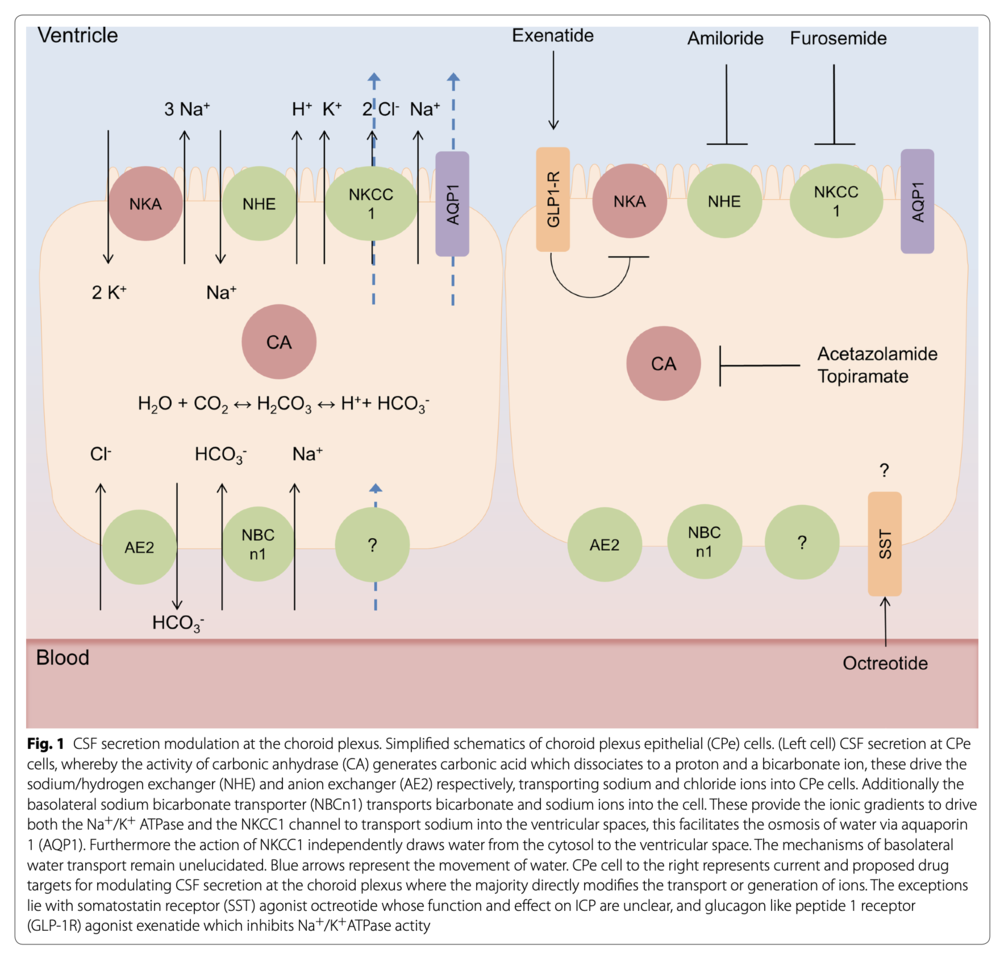
 Channel Your Enthusiasm
Channel Your Enthusiasm Chapter Three: The Proximal Tubule
Chapter Three: How the proximal tubule is like Elizabeth Warren and other truths my friends from Boston taught me


References for Chapter 3:
Faisy C, Meziani F, PLanquette B et al. Effect of Acetazolamide vs. Placebo on Duration of Invasive Mechanical Ventilation among patients with chronic obstructive pulmonary disease: a randomized clinical trial. JAMA 2016 https://pubmed.ncbi.nlm.nih.gov/26836730/
This randomized controlled double blinded multi-center study of acetazolamide to shorten the duration of mechanical ventilation (known as DIABLO) there was no statistically significant difference (though it may have been underpowered to do so).
Salazar H, Swanson J, Mozo K, White AC, Cabda MM Acute Mountain sickness impact among travelers to Cusco, Peru J Travel Med 2012 https://pubmed.ncbi.nlm.nih.gov/22776382/
Investigators found that altitude sickness is common and alters travel plans for 1 in 5 travelers but was prescribed infrequently.
Buzas GM and Supuran CT. Journal of enzyme inhibition and medicinal chemistry 2015 https://www.tandfonline.com/doi/full/10.3109/14756366.2015.1051042
This review describes the use of acetazolamide to treat peptic ulcers and how it was later learned that H. pylori have carbonic anhydrase
NORDIC idiopathic intracranial Hypertension Study Writing Committee. The effect of acetazolamide on visual function in patients with idiopathic intracranial hypertension and mild visual loss: the idiopathic intracranial hypertension treatment trial. JAMA 2014 https://pubmed.ncbi.nlm.nih.gov/24756514/
In this multi-centered trial, acetazolamide and low sodium weight reduction diet improved mild visual loss more than diet alone.
Mullens W et al. Rationale and design of the ADVOR (acetazolamide in decompensated heart failure with volume overload trial) Eur J Heart Failure 2018 https://pubmed.ncbi.nlm.nih.gov/30238574/
This reference explains the rationale for this ongoing trial.
Gordon CE, Vantzelfde S and Francis JM. Acetazolamide in Lithium-induced nephrogenic diabetes insipidus NEJM 2016 https://www.nejm.org/doi/full/10.1056/NEJMc1609483
A case report of efficacy of acetazolamide in a patient with severe polyuria.
Zehnder D et al. Expression of 25-hydroxyvitamin D-1alpha hydroxylase in the human kidney. JASN 1999
This report explores the activity in the enzyme in nephron segments and suggests that the distal nephron may play an important part in the formation of 1,25 vitamin D https://jasn.asnjournals.org/content/10/12/2465
Outline: Chapter 3
- This is chapter three, kind of the first real chapter of the book
- Proximal Tubule
- Reabsorbs 55-60% of the filtrate
- Active sodium resorption
- 65% of the sodium
- 55% of the chloride
- 90% of HCO3
- 100% glucose and amino acids
- Passive water resorption
- Water resorption is isosmotic
- Secretion of
- Hydrogen
- Organic anions
- Organic cations
- Anatomy
- S1, S2, S3 can be differentiated by peptidases
- S1 more sodium resorption and hydrogen secretion, high capacity
- S2 more organic ion secretion
- Cell model
- Basolateral membrane
- Na-K-ATPase powers all the resorption
- Luminal membrane
- 100 liters a day crosses the proximal tubule cells
- Microvilli to increase surface area
- Microvilli has brush border which has carrier proteins as well as carbonic anhydrase
- Water permeable, so sodium resorption leads to water resorption
- Aquaporin-1 (sounds like this transporter is unique to the proximal tubule and RBC)
- HCO3 is reabsorbed early, along with Na, resulting in increased chloride concentration which passively reabsorbed via paracellular route.
- Tight junction has only one strand (on freeze fracture) as opposed to 8 in distal nephron
- The Na-K-ATPase
- Lower activity than in the LOH and distal nephron
- Maintained intracellular Na at effective concentration of 30 mmol/L
- Interior of the cell is negative due to 3 sodium out and 2 K in, then K leaks back out.
- 3 Na out for 2 K in
- An ATP sensitive K outflow channel on the basolateral membrane
- Increased ATP slows potassium eflux
- The idea is if Na-K slows, ATP will accumulate and this will slow K leaving, because there is less potassium entering.
- K channel is ATP sensitive, ATP antagonizes K leak.
- Highly favorable ELECTROCHEMICAL gradient for sodium to flow into the cell through the luminal membrane
- Must be via a channel or carrier
- Cotransporters
- Amino acids
- Phosphate
- Glucose
- Called secondary active transport
- Countertransporters
- Only example is H excretion
- Basolateral membrane
- Na-3HCO3 transporter
- Powered by the negative charge in the cell
- Chloride resorption
- Formate chloride exchanger
- Formate combines with hydrogen in the lumen, becomes neutral formic acid, and is reabsorbed where the higher pH causes it to dissociate and recycle again.
- Dependent on continued H+ secretion
- Chloride moves across basolateral membrane thanks to Cl and KCl transporters, taking advantage of negative intracellular charge
- Passive mechanisms of proximal tubule transport
- Accounts for one third of fluid resorption
- Mechanism
- Early proximal tubule resorts most of the bicarb and less of the chloride
- Tubular fluid gets a high chloride concentration
- Chloride flows through the tight junction down its concentration gradient
- Sodium and water follow passively behind
- Water moves osmotically into intercellular space from tubular fluid even though the osmolalities are equal since chloride is an ineffective osmole, so tonicity is not the same. ******
- Argues that bicarb is primarily important solute for passive resorbtion
- Acetazolamide blocks Na and chloride resorption
- Similar thing happens with metabolic acidosis where less bicarb is available to drive passive resorbtion of Na and Cl
- Summary
- Other than Na-K-ATPase Na-H antiporter main determinant of proximal Na and water resorption
- 1. Direct bicarb resorption
- Preferential bicarb resorbtion proximally drives passive chloride resorption
- Drives active the formate exchanger for chloride resorption
- Neurohormonal influence
- AT2 drives a lot of Na resorption, primarily in S1 segment
- Does not have a net effect on H-CO3 movement
- Dopamine antagonizes sodium resorption
- Blocks both Na-K-ATPase and
- Na H antiporter
- Capillary uptake
- Starlings. Again
- Low hydraulic pressure due to glomerular arteriole
- High plasma on oncotic pressure from loss of the filtrate
- The two together promote resorption
- There maybe movement from interstitial back into tubular fluid (back diffusion) conflicting data
- Glomerular tubular balance
- The fractional tubular reabsorption remains constant despite changes in GFR (tubular load)
- It is essential the GFR is matched by resorption
- The rise in capillary osmotic pressure with increased GFR via increased filtration fraction is one mechanism of GT balance
- Glomerular tubular balance os one of three mechanisms that prevents fluid delivery from exceeding the resorptive capacity of the tubules
- GT balance
- TG feedback
- Autoregulation
- GT balance can be altered if patients are volume overloaded or depleted
- Closes this section with a story of a kid born without a brush border
- Primacy of sodium in proximal tubule activity
- Discusses bicarb resorbtion
- There is no Tm for Bicarb as long as volume overload is prevented, in rats can rise over 60!
- If you give NaHCO3 you get volume overload and the Tm I about 60
- Glucose
- S1 and S2 have high capacity, low affinity glucose resorption
- S3 has high affinity 2 Na fo every glucose
- Tm glucose is 375 mg/min
- For a GFR of 125t that comes out to 300mg/dL
- 125 ml/min * 3mg/ml (300 mg/dL) = 375 mg/min
- Functionally this is 200 mg/dL due to splay
- Urea
- Only 50-60 of filtered urea is excreted
- Calcium Loop and distal tubule
- Phosphate
- 3Na-Phosphate high affinity transporters late in proximal tubule
- three types of Na-Phos transporters, type 2 are the most important
- regulated by PTH and plasma phosphate
- PTH suppresses Phos resorption
-Metabolic acidosis also reduces phosphate resorption (good to have phosphate in the tubule to soak up H+
- Decreased tubular pH converts HPO42- to H2PO4- which has lower affinity for phosphate binding site
- Mg Loop and distal tubule
- Uric Acid
Why do I love acetazolamide?
- I love the proximal tubule
- Many uses
- Often forgotten
MOA
- Inhibit carbonic anhydrase
Main effects
- Renal: less bicarb reabsorption (ie less H secretion) à more distal Na/bicarb delivery à hypokalemic metabolic acidosis
- Brain: reduce CSF production, reduce ICP/IOP, aqueous humor
- Pulm: COPD
Notes
- Tolerance develops in 2-3 days
- Sulfonamide derivative
- Highly protein bound, eliminated by kidneys

Source: Buzas and upuran, JEIMC, 2016S
Data:
1968 - High altitude
High altitude usually results in respiratory alkalosis
Acetazolamide – lessens symptoms of altitude sickness (insomnia, headache) which occur because of periodic breathing/apnea
1979- NEJM study took 9 mountaineers asleep at 5360 meters à improvement in sleep, improved SaO2 from 72 to 78.7 mmHg, reduce periodic breathing, increased alveolar ventilation (pCO2 change from 37 mmHg to 30.8mm Hg)
1950s - Seizures/migraines
CAI reduces pH (more H intracellularly), K movement extracellularly à hyperpolarization and increase in seizure threshold
Weak CAI (Topamax, zonisamide) but not though to be important mechanism of antiseizure effect (topamax enhances inhibitory effect of GABA, block voltage dependent Na and Ca channels)
Pulmonary/COPD
Thought to help with the metabolic alkalosis and as a respiratory stimulant to increase RR, TV, reduce ventilator time
In 2001 Cochrane review – no difference in clinical outcomes, but did reduce pH and bicarb minimally
DIABLO study (RCT) on ventilated COPD patients – no difference in median duration of mechanical ventilation despite correction of metabolic alkalosis
High altitude erythropoiesis (Monge disease)
First described in 1925 via Dr. Carlos Monge Medrano (Peruvian doctor), seen in people living > 2500-3000 meters (more common in South America than other high altitude areas)
Usually chronic altitude sickness with HgB > 21 g/dL + chronic hypoxemia, pHTN
Acetazolamide – reduces polycythemia because induces a met acidosis à increases ventilation and arterial PPO2 and SaO2 à blunts erythropoiesis and reduces HCT and improves pulmonary vascular resistance
GI ulcers
When H2 and PPI available, less use
History: 1932 – observed alkaline tide, presumed existence of gastric CA (demonstrated in 1939)
Acetazolamide was used to inhibit acid secretion in 1960s, ulcer symptoms, with reversible metabolic acidosis, BUT lots of SE (electrolyte losses, used Na/K/Mg salts to help, renal colic, headache, fatigue, etc)
Later found H. Pylori encodes for two different Cas
Helps to acclimatize to acidic environment
Basically, the Ca changes CO2 into H+ and HCO3
They also have a urease which produces NH3
The NH3 binds with H+, leaving an alkaline environment for them to live in
Inhibition of CA with acetazolamide is lethal for pathogen in vitro
1940s
Found there was CA in pancreas
Thought acetazolamide to reduce volume of secretions from NGT (output from exocrine pancreas)

Source: Human Anatomy at Colby Blog
Diuretic resistance
If develop hyperchloremic metabolic alkalosis, short course of acetazolamide + spironolactone (b/c need distal Na blockage) à can help
May help with urine alkalization (ie uric acid stone) but increases risk of calcium phosphate stones
ADVOR trial
acetazolamide in HF exacerbation in Belgium
use may help to prevent new episode, lower total diuretic dose
CSF reduction (pseudotumor cerebri)
Reduces CSF by as much as 48% when > 99.5% of CA in choroid plexus is inhibited
NORDIC trial (acetazolamide v. placebo) – improvement in visual symptoms especially if advanced papilledema, and reduced opening pressure)
Side note also used off label to help with increased ICP and CSF leaks, as alternative to VP shunts, repeat LPs, etc

